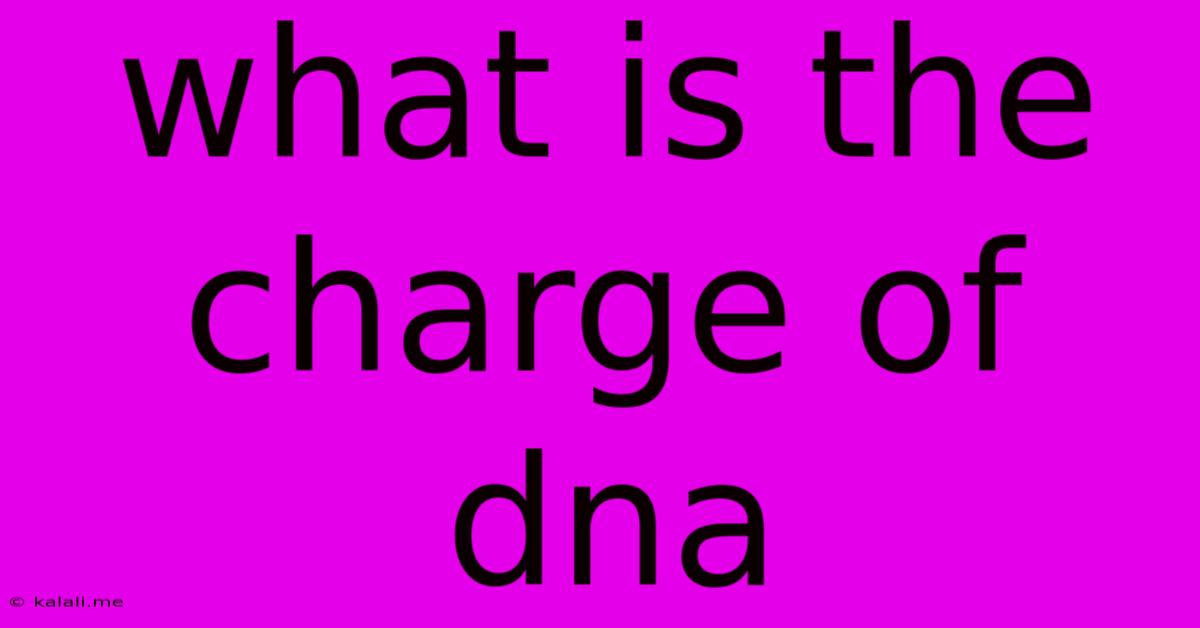What Is The Charge Of Dna
Kalali
Jun 04, 2025 · 3 min read

Table of Contents
What is the Charge of DNA? A Deep Dive into the Electrostatic Properties of the Genetic Material
DNA, the blueprint of life, isn't just a passively stored instruction manual. Its function relies heavily on its inherent physical and chemical properties, one of the most crucial being its overall negative charge. Understanding this charge is key to understanding how DNA replicates, transcribes, and interacts with proteins within the cell. This article will explore the source of DNA's negative charge, its implications for DNA structure and function, and the relevance of this property in various biological processes.
The Source of DNA's Negative Charge:
The negative charge of DNA stems directly from its phosphate backbone. Each nucleotide, the building block of DNA, consists of a deoxyribose sugar, a nitrogenous base (adenine, guanine, cytosine, or thymine), and a phosphate group. It's this phosphate group that carries the negative charge. Specifically, the phosphate group contains two negatively charged oxygen atoms. These negatively charged oxygen atoms, present along the entire length of the DNA molecule, give DNA its overall strongly negative charge. This isn't a small, insignificant charge; it significantly impacts DNA's behavior and interactions.
Implications of DNA's Negative Charge:
The negative charge of DNA has far-reaching implications:
-
DNA Structure and Stability: The negatively charged phosphate backbone repels itself. This repulsion contributes to the double helix structure of DNA. The twisting of the double helix is, in part, a consequence of the electrostatic repulsion between the negatively charged phosphates. If the repulsion were not there, DNA might adopt a different, less stable conformation.
-
DNA Packaging: The high negative charge density of DNA necessitates tight packaging within the cell. This is achieved through the association of DNA with positively charged proteins, such as histones. These histone proteins neutralize the negative charge of DNA, allowing it to be condensed into chromatin, thus fitting into the cell nucleus. This interaction is crucial for regulating gene expression and protecting the DNA from damage.
-
DNA Replication and Transcription: The negative charge of DNA plays a role in the processes of DNA replication and transcription. The enzymes involved in these processes, such as DNA polymerase and RNA polymerase, possess positively charged regions that interact with the negatively charged DNA backbone. These interactions help the enzymes accurately bind to DNA and carry out their functions.
-
DNA-Protein Interactions: Many proteins interact with DNA, and these interactions are often mediated by electrostatic forces. Transcription factors, repair enzymes, and other proteins frequently contain positively charged domains that bind to the negatively charged DNA. The strength and specificity of these interactions are influenced by the charge distribution on both the DNA and the protein.
-
Electrophoretic Mobility: The negative charge of DNA is exploited in laboratory techniques such as gel electrophoresis. In this technique, DNA fragments are separated based on their size by applying an electric field. The negatively charged DNA molecules migrate towards the positive electrode, allowing researchers to visualize and analyze DNA samples.
Further Considerations:
While the overall charge of DNA is negative, the local charge distribution can vary depending on the nucleotide sequence and the surrounding environment. This variation in local charge can contribute to the binding specificity of DNA-binding proteins. Furthermore, chemical modifications of DNA, such as methylation, can alter the local charge and influence DNA-protein interactions.
In conclusion, the negative charge of DNA is a fundamental property that profoundly influences its structure, stability, and function. Understanding this crucial aspect of DNA's chemistry is essential to comprehending the intricate workings of the cell and the processes that govern life itself. Future research into the complexities of DNA's electrostatic properties will undoubtedly continue to uncover new insights into the fundamental mechanisms of life.
Latest Posts
Latest Posts
-
How Do I Find My Facebook Likes
Jun 06, 2025
-
How To Change Affinity Elden Ring
Jun 06, 2025
-
Asking For An Extension From A Stsrting Date
Jun 06, 2025
-
Is Superman From Marvel Or Dc
Jun 06, 2025
-
Condensation Point Of Water In Celsius
Jun 06, 2025
Related Post
Thank you for visiting our website which covers about What Is The Charge Of Dna . We hope the information provided has been useful to you. Feel free to contact us if you have any questions or need further assistance. See you next time and don't miss to bookmark.